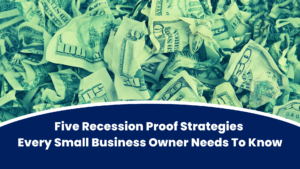By Kim Folsom
This is Part 1 of a three-part series that explores how small businesses can add new and recurring revenues to stabilize their income and grow.
You can never rest on your laurels when you’re running a business — particularly these days. We’ve endured the pandemic and an economic downturn for over a year. Given that, it’s time to take stock of how we’re doing business and evaluate how we can do better.
How can you add new streams of revenue to not only keep you afloat but accelerate your growth? Here are 8 ways.
- Strengthen your customer base
It’s always easier and cheaper to keep an existing customer than it is to find a new one. Don’t take your customers for granted. Treat them like loyalty. Really dig deep. Call them. Find out what they are struggling with. What are their problems and pain points? You might be able to solve their issues with a current offering. Or you might come up with an entirely new offering. Having deep empathy for your customer and getting to know them really well can lead to innovations for whole new product lines.
2. Give more value than you get
Overwhelm your customers and clients. Give them something so over-the-top valuable that they can’t refuse, that they can’t live without. At least make it feel like the value they are getting is way more than the price.
When you listen to your customer, figure out their pain points, provide an offering that won’t break the bank, and make sure the value is perceived much higher than the dollar amount they’re paying, you’ll have long-term customers and won’t have to put in so much effort to keep finding new ones.
3. Act like a startup
When you’re trying to come up with ideas for recurring revenue, you have to act like a startup. Move fast. Test, test, and test some more. Hack together a landing page to see if customers might be interested in a new offering before you spend a dime building it. Experiment with revenue streams that you might have never thought of before. Can you monetize different parts of your funnel from different sources? Can an existing offering serve a different kind of customer?
One of the silver linings of COVID-19 is that companies have had to innovate to survive. Don’t be afraid to fail when you experiment — just do it cheaply and fast.
4. Evaluate your entire business
Look at what you’re doing as a whole. Where are there opportunities to add value? Are customers dropping out of your funnel? Where and why? Could a subscription product solve the problem? Can you re-engage with customers who have dropped off? Can you give more to those stalwart clients who have been with you through thick and thin? Look at all the expenses across your company. Can you turn any of them into revenue generation by partnering with another company?
5. Examine similar industries
Would your business model work in a similar industry? Could you move laterally to build a new customer base? I’m not talking about reinventing the wheel or starting over. You might have a business model that would easily translate to another industry and open a whole new world of revenue.
6. Extend your product line
When you’re trying to diversify revenue streams, look at your existing product line to see where you can extend it. You can do this in two ways. You can extend the offering with add-on, ancillary services to your core business. Or you can extend your offerings to a different type of customer. For example, if you sell to corporate behemoths, can you come up with an offering that would be cost effective for small businesses?
7. Steal from your competitors
OK, I don’t mean steal like rob a 7Eleven. I mean, study what your competitors are doing. Or really, examine what other small businesses are doing even if they are not in your industry. You might be inspired by what you see. A whole host of brick-and-mortar businesses have had to move online during the pandemic. Yoga studios have gone virtual. Coffee shops are selling coffee beans online. Can you take a page out their playbook to create a new revenue stream?
8. Prepare for the new normal
No matter what, as we get through the pandemic, you’ll have to plan for a new normal once COVID-19 is finally under control. Trust me, I’ve worked through four different recession in six different companies over the years. The one thing I know for sure when you get out the other side is that the business climate is never the same after a recession. So plan for a new normal. But don’t despair. A lot of innovation comes out of stressful times. As they say, starvation leads to innovation.
Well, I hope you don’t starve. Instead, I hope you see new opportunities for new revenues as we come out of these trying times.
Kim Folsom is the founder and CEO of Founders First Capital Partners, which has helped accelerate the success of hundreds of small, service-based, business-to-business companies since 2015. Visit our website to learn more.




